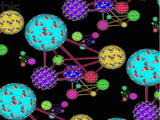IMDEA Networks

Event Category: In-house Presentation
RIA-ICCS: Intercell Coordinated Scheduling Exploiting Application Reservation Information
Intercell coordination and cooperation techniques are some of the most promising approaches to increase the spectral efficiency of future wireless systems as required by
the forecasted market needs. Among them, intercell coordinated scheduling (ICCS) arises as a near-term feasible solution due to its lower inter-BS communication requirements when compared to full cooperative approaches. In this paper we present our proposed Reservation Information Aware Intercell Coordinated Scheduling (RIA-ICCS) solution which considers application reservation information when constructing an interference graph for ICCS purposes.
Adaptive Modulation for Finite-Horizon Multicasting of Erasure-coded Data
We design an adaptive modulation scheme to support opportunistic multicast scheduling in wireless networks. Whereas prior work optimizes capacity, we investigate the finite horizon problem where (once or repeatedly) a fixed number of packets has to be transmitted to a set of wireless receivers in the shortest amount of time -- a common problem, e.g., for software updates or video multicast.
Seguir leyendo arrow_right_altEnergy-Efficient Wireless Access Networks
Energy efficiency is one of the great technological challenges of our times. Recently, the concerns for the environmental consequences of the huge rate with which energy is consumed is leading to the awareness that electricity consumption and waste should be reduced in all sectors. The ICT (Information and Communication Technology) sector makes no exception, since it is becoming a major component of the worldwide energy consumption budget.
Seguir leyendo arrow_right_alt
Online Testing of Distributed Systems
It is notoriously difficult to make distributed systems reliable. This becomes even harder in the case of the widely-deployed systems that are heterogeneous (multiple implementations) and federated (multiple administrative entities).
Seguir leyendo arrow_right_altVirtual Reality and Haptics Applications in e-Learning, Industrial Training and Medical Education
Nicolas Georganas received the Dip. Ing. (Diplom-Ingenieur - German equivalent of M.Sc. degree) in Electrical Engineering from the National Technical University of Athens (Athens, Greece) in 1966. He went on to achieve his Ph.D. in Electrical Engineering (Summa cum Laude) in 1970 from the University of Ottawa (Ottawa, Canada). In 2004, he was conferred a Dr-Ing. (Doktor Ingenieur) (honoris causa) in Electrical Engineering by the Technische Universität Darmstadt (Darmstadt, Germany). In 2007, he was awarded his second Ph.D. (honoris causa) in Electrical and Computer Engineering by the National Technical University of Athens. He currently holds the position of Distinguished University Professor in the School of Information Technology and Engineering (SITE) of the University of Ottawa. In addition to this, he is also a Visiting Researcher at IMDEA Networks and a Cátedra de Excelencia at University Carlos III of Madrid (UC3M). In 1986 he became the Founding Dean of the University of Ottawa’s Faculty of Engineering, and from 2005-08 served as Associate Vice-President, Research (External).
Seguir leyendo arrow_right_altFlat Access and Mobility Architecture: an IPv6 Distributed Client Mobility Management solution
The use of centralized mobility management approaches – such as Mobile IPv6 – poses some difficulties to operators of current and future networks, due to the expected large number of mobile users and their exigent demands. All this has triggered the need for distributed mobility management alternatives, that alleviate operators’ concerns allowing for cheaper and more efficient network deployments.
Seguir leyendo arrow_right_alt
Algorithmic Mechanisms for Internet Supercomputing under Unreliable Communication
This work, using a game-theoretic approach, considers Internet-based computations, where a master processor assigns, over the Internet, a computational task to a set of untrusted worker processors, and collects their responses. The master must obtain the correct task result, while maximizing its benefit. Building on prior work, we consider a framework where altruistic, malicious, and rational workers co-exist. In addition, we consider the possibility that the communication between the master and the workers is not reliable, and that workers could be unavailable; assumptions that are very realistic for Internet-based master-worker computations.
Seguir leyendo arrow_right_altTREBOL: Tree-Based Routing and Address Autoconfiguration for Vehicle-to-Internet Communications; New Insights from the Analysis of Free Flow Vehicular Traffic in Highways
Efficient vehicle-to-Internet routing and address autoconfiguration are two of the missing pieces required to provide Internet connectivity from vehicles. Here, we propose TREBOL, a tree-based and configurable protocol which benefits from the inherent tree-shaped nature of vehicle to Internet traffic to reduce the signaling overhead while dealing efficiently with the vehicular dynamics.
Seguir leyendo arrow_right_altOptimization in optical networks
In the talk I overview some recent results for optimization problems that originate in optical networks. They deal with optimizing the utilization of regenerators (switching components that regenerate a signal after a certain distance) and ADMs (Add-Drop Multiplexers).
Seguir leyendo arrow_right_altTREND Project Plenary Meeting & Open Day
On Sep 26th and 27th we organize a meeting of the EU project TREND. The research conducted in this project is in the field of energy efficient networking. The second day of the project is dedicated to several research talks by members of the project as well as some external speakers. Those interested in attending to these sessions are welcome to do so. The only requirement is to complete the registration form by Thursday, September 22nd
Seguir leyendo arrow_right_alt












Comentarios recientes